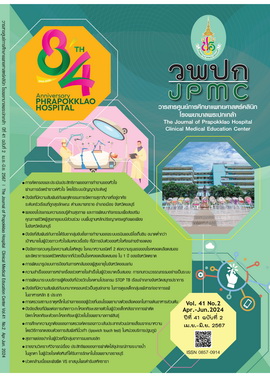ปัจจัยเสี่ยงที่มีผลต่อการเกิดภาวะกะโหลกศีรษะสลายตัวในผู้ป่วยเด็กหลังจากการผ่าตัดปิดกะโหลกศีรษะด้วยกะโหลกศีรษะผู้ป่วยในโรงพยาบาลกาฬสินธุ์
Main Article Content
บทคัดย่อ
ที่มาของปัญหา: ผู้ป่วยเด็กเสียชีวิตจากโรคบาดเจ็บสมองประมาณร้อยละ 4.1 การผ่าตัดส่วนใหญ่คือ การผ่าตัดเปิดกะโหลกศีรษะ และตามด้วยการผ่าตัดปิดกะโหลกศีรษะ ซึ่งมักมีภาวะแทรกซ้อนเกิดขึ้น
วัตถุประสงค์: เพื่อศึกษาภาวะแทรกซ้อนของการผ่าตัดปิดกะโหลกศีรษะด้วยกะโหลกศีรษะผู้ป่วย และปัจจัยเสี่ยงที่มีผลต่อการเกิดภาวะกะโหลกศีรษะสลายตัวในผู้ป่วยเด็กหลังการผ่าตัดปิดกะโหลกศีรษะด้วยกะโหลกศีรษะผู้ป่วย
วิธีการศึกษา: การศึกษาแบบย้อนหลัง (retrospective case control study) ในผู้ป่วยที่ได้รับการผ่าตัดปิดกะโหลกศีรษะ ในโรงพยาบาลกาฬสินธุ์ ตั้งแต่ตุลาคม พ.ศ. 2563 ถึงพฤษภาคม พ.ศ. 2566 โดยเก็บข้อมูลจากเวชระเบียนและเอกซเรย์คอมพิวเตอร์ และการวิเคราะห์ข้อมูลใช้สถิติเชิงพรรณนา และใช้สถิติ Fisher’s exact test และ Mann-Whitney U test
ผลการศึกษา: มีผู้ป่วยเด็กจำนวน 22 ราย ได้รับการผ่าตัดปิดกะโหลกศีรษะด้วยกะโหลกศีรษะผู้ป่วย พบว่าภาวะแทรกซ้อนที่พบมากที่สุด คือ ภาวะกะโหลกศีรษะสลายตัว และปัจจัยเสี่ยงที่มีผลต่อการเกิดภาวะกะโหลกศีรษะสลายตัว พบว่ากะโหลกศีรษะที่ผ่าตัดออกมีขนาดใหญ่ (p=0.04) กะโหลกศีรษะที่ผ่าตัดออกมีขนาดใหญ่กว่า 115 ตารางเซนติเมตร (p=0.02) และผู้ป่วยภาวะสมองช้ำตั้งแต่แรกรับ (p=0.006) มีความสัมพันธ์กับการเกิดภาวะกะโหลกศีรษะสลายตัวอย่างมีนัยสำคัญทางสถิติ
สรุป: ผู้ป่วยในโรงพยาบาลกาฬสินธุ์ยังคงต้องปิดกะโหลกศีรษะด้วยกะโหลกศีรษะตัวเอง เนื่องจากปัญหาเรื่องค่าใช้จ่ายและมีความพอดีมากกว่า ดังนั้น จึงจำเป็นต้องเลือกผู้ป่วยให้เหมาะสม โดยผู้ป่วยที่มีกะโหลกศีรษะแหว่งขนาดใหญ่ และมีภาวะสมองช้ำ ควรมีการติดตามอย่างเป็นระยะ และนานกว่าผู้ป่วยปกติ เพื่อหลีกเลี่ยงภาวะกะโหลกศีรษะสลายตัว และทำให้ไม่ต้องรับการผ่าตัดซ้ำ
คำสำคัญ: การปิดกะโหลกศีรษะในผู้ป่วยเด็ก, ภาวะกะโหลกศีรษะสลายตัว, การปิดกะโหลกศีรษะด้วยกะโหลกศีรษะผู้ป่วย, ภาวะแทรกซ้อน
Thaiclinicaltrials.org number, TCTR20240609003
Article Details

อนุญาตภายใต้เงื่อนไข Creative Commons Attribution-NonCommercial-NoDerivatives 4.0 International License.
เอกสารอ้างอิง
Centers for Disease Control and Prevention. Surveillance report of traumatic brain injury-related deaths by age group, sex,and mechanism of injury-United States, 2018 and 2019 [Internet]. 2022 [cited 2024 Jan 2]. Available from: https://www.cdc.gov/traumaticbraininjury/pdf/tbi-surveillance-report-2018-2019-508.pdf
Alexiou G, Prodromou N, editors. Pediatric neurosurgery for clinicians. Cham: Springer Nature Switzerland AG; 2022.
Thongmeesi S. 2021 Thailand trauma statistics in adult (age 16-60 yr.) [Internet]. 2022 [cited 2024 Jan 2]. Available from: http://49.231.15.21/crhfileload/upload/files/TEAF256504272018203421.pdf
Lui A, Kumar KK, Grant GA. Management of severe traumatic brain injury in pediatric patients. Front Toxicol [Internet] 2022 [cited 2024 Jan 1];4:910972. Available from: https://www.ncbi.nlm.nih.gov/pmc/articles/PMC9263560/pdf/ftox-04-910972.pdf
Honeybul S, Kolias AG, editors. Traumatic brain injury: science, practice, evidence and ethics. Cham: Springer Nature Switzerland AG; 2021.
Derakhshanfar H, Pourbakhtyaran E, Rahimi S, Sayyah S, Soltantooyeh Z, Karbasian F. Clinical guidelines for traumatic brain injuries in children and boys. Eur J Transl Myol [Internet]. 2020 [cited 2024 Jan 1];30(1):8613. Available from: https://www.ncbi.nlm.nih.gov/pmc/articles/PMC7254418/pdf/ejtm-30-1-8613.pdf
Salama AA, Ibbett I, Thani N. Paediatric cranioplasty: a review. Interdisciplinary Neurosurgery 2018;13:59-65.
Brommeland T, Rydning PN, Pripp AH, Helseth E. Cranioplasty complications and risk factors associated with bone flap resorption. Scand J Trauma ResuscEmerg Med [Internet]. 2015 [cited 2024 Jan 1];23:75. Available from: https://www.ncbi.nlm.nih.gov/pmc/articles/PMC4595108/pdf/13049_2015_Article_155.pdf
Hersh DS, Anderson HJ, Woodworth GF, Martin JE, Khan YM. Bone flap resorption in pediatric patients following autologous cranioplasty. Oper Neurosurg (Hagerstown) 2021;20:436-43.
Poolsawat A, Jitpun E. Complications of cranioplasty using autologous bone graft versus syntheticbone tissue following decompressive craniectomy for traumatic brain injury. Buddhachinaraj Med J 2023;37:347-55.
Rocque BG, Amancherla K, Lew SM, Lam S. Outcomes of cranioplasty following decompressive craniectomy in the pediatric population. J Neurosurg Pediatr 2013;12:120-5.
Krejcie RV, Morgan DW. Determining sample size for research activities. Educational and Psychological Measurement 1970;30:607-10.
Bowers CA, Riva-Cambrin J, Hertzler DA 2nd, Walker ML. Risk factors and rates of bone flap resorption in pediatric patients after decompressive craniectomy for traumatic brain injury. J Neurosurg Pediatr 2013;11:526-32.
Rocque BG, Agee BS, Thompson EM, Piedra M, Baird LC, Selden NR, et al. Complications following pediatric cranioplasty after decompressive craniectomy: a multicenter retrospective study. J Neurosurg Pediatr 2018;22:225-32.
Primalani NK, Chew KY, Ramachandran S, Ng LP, Low DCY, Seow WT, et al. Paediatriccranioplasty-experience from a Singapore children’s hospital. Interdisciplinary Neurosurgery [Internet]. 2022 [cited 2024 Jan 1];30:101606. Available from: https://www.sciencedirect.com/science/article/pii/S2214751922001207/pdfft?md5=caef829b900147c7078d292d6a357b28&pid=1-s2.0-S2214751922001207-main.pdf

